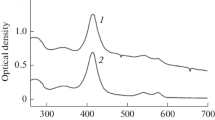Summary
Insulin degradation by human erythrocyte fractions was studied using the TCA-precipitation method. Hemolysate exhibited an insulin degrading activity higher than membranes. Triton X-100 treatment of membranes led to the appraisal of Triton-soluble degrading activity and of a more efficient Triton-not-soluble degrading activity. Monovalent cations (Na+, K+, Li+) did not modify the insulin degradation by any of the erythrocyte fractions. Divalent cations, Ca++ and Zn++ selectively enhanced insulin degradation by the membranous fractions, and Cu++ and Zn++ strongly inhibited insulin degradation by all the erythrocyte fractions. The results supported the hypothesis of the existence of at least two different degrading systems in human erythrocytes: soluble (cytosolic) Ca++ and Mg++ insensitive system(s) and membrane associated Ca++ and Mg++ sensitive system(s).
Similar content being viewed by others
References
Andreani D., De Pirro R., Lauro R., Olefsky J. M., Roth J. (Eds): Current views on insulin receptors. Academic Press, New York, 1981.
Bellomo G., Bellazzi R., Nicotera P. L., Francesconi R., Fratino P.: Binding and degradation of125I-insulin in human erythrocyte. Comparative studies with hemolysate and membranes — J. endocrinol. Invest.5, 287, 1982.
Bellomo G., Nicotera P. L., Parini A., Fratino P.: Insulin degradation in human erythrocyte. Effects of Triton X-100 treatment on insulin degrading activity of membranes — J. endocrinol. Invest.6, 441, 1983.
Boyoum A.: A one stage procedure for isolation of granulocytes and lymphocytes from human blood. General sedimentation properties of white blood cells in a 1 g gravity field — Scand. J. clin. Lab. Invest.21 (Suppl. 97), 51, 1968.
Burghen G. A., Kitabchi A. E., Brush J. S.: Characterization of a rat liver protease with specificity for insulin — Endocrinology91, 633, 1972.
Dukworth W. C.: Insulin and glucagon degradation by isolated kidney cell membranes — Endocrinology102, 1766, 1978.
Freychet P., Kahn C. R., Roth J., Nevile D. M. Jr.: Insulin interaction with liver plasma membranes. Independence of binding of the hormone and its degradation — J. biol. Chem.247, 3953, 1972.
Gambhir K. K., Archer J. A., Bradley C. J.: Characteristics of human erythrocyte insulin receptors — Diabetes27, 701, 1978.
Gambhir K. K., Nerurkar S. G., Das P. D., Archer J. A., Henry L.: Insulin binding and degradation by human erythrocytes at physiological temperature — Endocrinology109, 1787, 1981.
Gammeltoft S., Gliemann J.: Binding and degradation of125I-labelled insulin by isolated rat fat cells — Biochim. biophys. Acta (Amst.)320, 16, 1973.
Hammond J. M., Jarett L.: Insulin degradation by isolated fat cells and their subcellular fractions — Diabetes24, 1011, 1975.
Le Cam A., Freychet P., Lenoir P.: Degradation of insulin by isolated rat liver cells — Diabetes24, 866, 1978.
Lowry O. H., Rosebrough N. J., Farr A. L., Randall R. J.: Protein measurement with the Folin phenol reagent — J. biol. Chem.193, 265, 1958.
Suzuki K., Kono T.: Internalization and degradation of fat cell bound insulin — J. biol. Chem.254, 9786, 1979.
Tokes Z. A., Chambers S. M.: Proteolytic activity associated with human erythrocyte membranes. Self digestion of isolated human erythrocyte membranes — Biochim. biophys. Acta (Amst.)389, 325, 1975.
Yokono K., Imamura Y., Sakai H., Baba S.: Insulin degrading activity of plasma membranes from rat skeletal muscle. Its isolation, characterization, and biologic significance — Diabetes28, 810, 1979.
Author information
Authors and Affiliations
Rights and permissions
About this article
Cite this article
Bellomo, G., Nicotera, P.L., Travaglino, F. et al. Insulin degradation in human erythrocyte: Effects of cations. Acta diabet. lat 22, 63–69 (1985). https://doi.org/10.1007/BF02591094
Received:
Issue Date:
DOI: https://doi.org/10.1007/BF02591094




